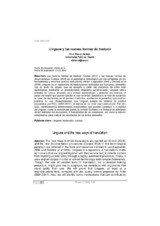Mostrar el registro sencillo del ítem
Linguee y las nuevas formas de traducir
| dc.contributor.author | Alonso Jiménez, Elisa | |
| dc.date.accessioned | 2018-02-08T12:10:36Z | |
| dc.date.available | 2018-02-08T12:10:36Z | |
| dc.date.issued | 2013 | |
| dc.identifier.issn | 2255-3703 | |
| dc.identifier.uri | http://hdl.handle.net/10396/16111 | |
| dc.description.abstract | Las nuevas formas de traducir (Cronin 2010) y las nuevas formas de documentarse (Corpas 2004) en el paradigma tecnológico se ven reflejadas en las herramientas y recursos que los traductores utilizan (Lagoudaki 2006 y Désilets et al 2009). Linguee es un repositorio de traducciones realizadas por humanos, alineadas con su texto de origen, que se recopila a partir del contenido de sitios web multilingües, mediante un procedimiento altamente automatizado. Linguee utiliza además su corpus alineado para extraer terminología y elaborar diccionarios. A pesar del recelo que puede suscitar el uso de textos paralelos a la hora de sustentar la toma de decisiones en el proceso traductor, aportamos argumentos que podrían justificar su uso. Demostraremos que Linguee cumple los criterios de calidad propuestos por Pinto (2004-2011), al menos en su nivel macroestructural. Por otro lado, identificaremos determinados mecanismos que pueden contribuir a la calidad de Linguee, como la revisión por pares, la revisión humana y el historial de ediciones de las entradas del diccionario, la trazabilidad de los contenidos, así como la edición colaborativa para matizar los resultados de los textos alineados. | es_ES |
| dc.description.abstract | The new ways in which translations are carried out (Cronin 2010), and the new documentation procedures (Corpas 2004) in the technological paradigm are reflected in the tools and resources translators use (Lagoudaki 2006 and Désilets et al 2009). Linguee is a repository of translations made by humans that are aligned together with their source text; it collects content from multilingual web sites, through a highly automated procedure; finally, it uses aligned corpus in order to extract terminology and compile dictionaries. Though the use of parallel texts in translation, as a decision-making procedure, might give rise to suspicion, we contribute with arguments that could justify their use. We will prove that Linguee, at least at a macrostructural level, complies with the quality criteria proposed by Pinto (2004-2011). Also, we will identify some mechanisms that can contribute to quality in Linguee, such as peer-review, human review and history of editions in dictionary entries, traceability of content, as well as collaborative edition that can refine the aligned texts obtained from searches. | es_ES |
| dc.format.mimetype | application/pdf | es_ES |
| dc.language.iso | spa | es_ES |
| dc.publisher | UCOPress | es_ES |
| dc.rights | https://creativecommons.org/licenses/by/3.0/ | es_ES |
| dc.source | Skopos 2, 5-28 (2013) | es_ES |
| dc.subject | Linguee | es_ES |
| dc.subject | Traducción | es_ES |
| dc.subject | Corpus | es_ES |
| dc.subject | Translation | es_ES |
| dc.title | Linguee y las nuevas formas de traducir | es_ES |
| dc.title.alternative | Linguee and the new ways of translation | en |
| dc.type | info:eu-repo/semantics/article | es_ES |
| dc.relation.publisherversion | https://www.uco.es/ucopress/ojs/index.php/skopos/index | es_ES |
| dc.rights.accessRights | info:eu-repo/semantics/openAccess | es_ES |

